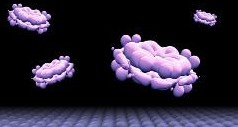"With each additional day, the preparation of graphene by Zorn approaches a level of commercial readiness, and the findings of this study advance the field one more step," explains researcher James Tour from Rice University

The computers of the future should be a little sweeter, thanks to the improvement of the graphene production process carried out at Rice University.
Researchers at Rice University have found a way to make clean sheets of graphene, the monoatomic form of carbon, from regular table sugar and other carbon-based materials. They were able to do this using a one-step process at a temperature low enough to make graphene production simpler.
Researchers from the laboratory of chemist James Tour from Rice University report in the prestigious journal Nature that it is possible to prepare large sheets of high-quality graphene from several carbon sources at relatively low temperatures of 800 degrees Celsius. Despite such a high temperature, the difference in the operation of an oven at a temperature of 800 degrees Celsius compared to 1000 degrees Celsius is significant, notes the lead researcher.
"At 800 degrees Celsius the crucible substrate remains active for electronic uses, while at a temperature of 1000 degrees Celsius it loses most of its activity," said the lead researcher.
Zhengzong Sun, an undergraduate student in the researcher's lab and first author of the paper, found that placing high-carbon sources on a copper or nickel substrate gave rise to graphene in any desired shape: single-, double-, or multi-layered sheets that could be very useful in a number of applications. applications.
The researchers discovered that the method can be easily adapted for the production of solidified graphene; This type of graphene, which contains targeted and predefined impurities of other materials within it, allows the electronic and optical properties of the final material to be changed - a very important feature in the preparation of switching devices and logic circuits.
In order to obtain this type of clean graphene, the researchers started with a thin layer of the material polymethyl methacrylate (PMMA) - better known as acrylic glass (plexiglass, plexiglass, acrylic, acrylplast) - which was placed on a copper substrate that serves as a catalyst. Flowing hydrogen gas and arranging it through the layers while heating and under low pressure for only 10 minutes reduced them to pure carbon and turned the layer into a monoatomic sheet of graphene. Changing the gas flow rate allows the researchers to control the thickness of the resulting graphene layer.
Things became more fascinating later, notes the researcher. They turned to other carbon sources, including powdered sucrose, which we all know as table sugar. "We thought it would be interesting to try this material," said the researcher. "While in other laboratories the scientists change the type of metal catalyst, we tried to change the sugar sources."
The researcher placed 10 milligrams of sugar on a sheet of copper foil measuring one cm and exposed it to the same reaction conditions as was done with the acrylic glass. Very quickly the mixture turned into single-layer graphene. The researchers hypothesized that the finished product would have structural defects since the chemical properties of the two materials are slightly different. However, to the surprise of the researchers, the structural defects that are created, correct themselves during the creation of the graphene. "The more we looked at the process more and more deeply, we found that it is not only interesting, but also useful," adds the researcher.
The researchers were unable to create graphene from Zorn and Zorn oxide surfaces, a finding that led to the possibility of producing patterned graphene from a thin layer of copper or nickel placed on Zorn wafers.
Strained graphene (deliberately contaminated) allows more uses in the field of electronic components and the researchers found that it is quite easy to prepare. To this end, the acrylic glass is mixed with a solidifying material (melamine) and gas is injected into it at atmospheric pressure to obtain graphene solidified with nitrogen atoms. Pure graphene does not have a band gap, but strained graphene allows control over the electronic structure, which leads to the preparation of field-effect transistors.
"Every additional day, the preparation of graphene by Zoran approaches a level of commercial readiness, and the findings of this research advance the field one more step," Tor explains.

2 תגובות
What are the advantages of graphene over silicon?
Really good news 🙂
Thanks.